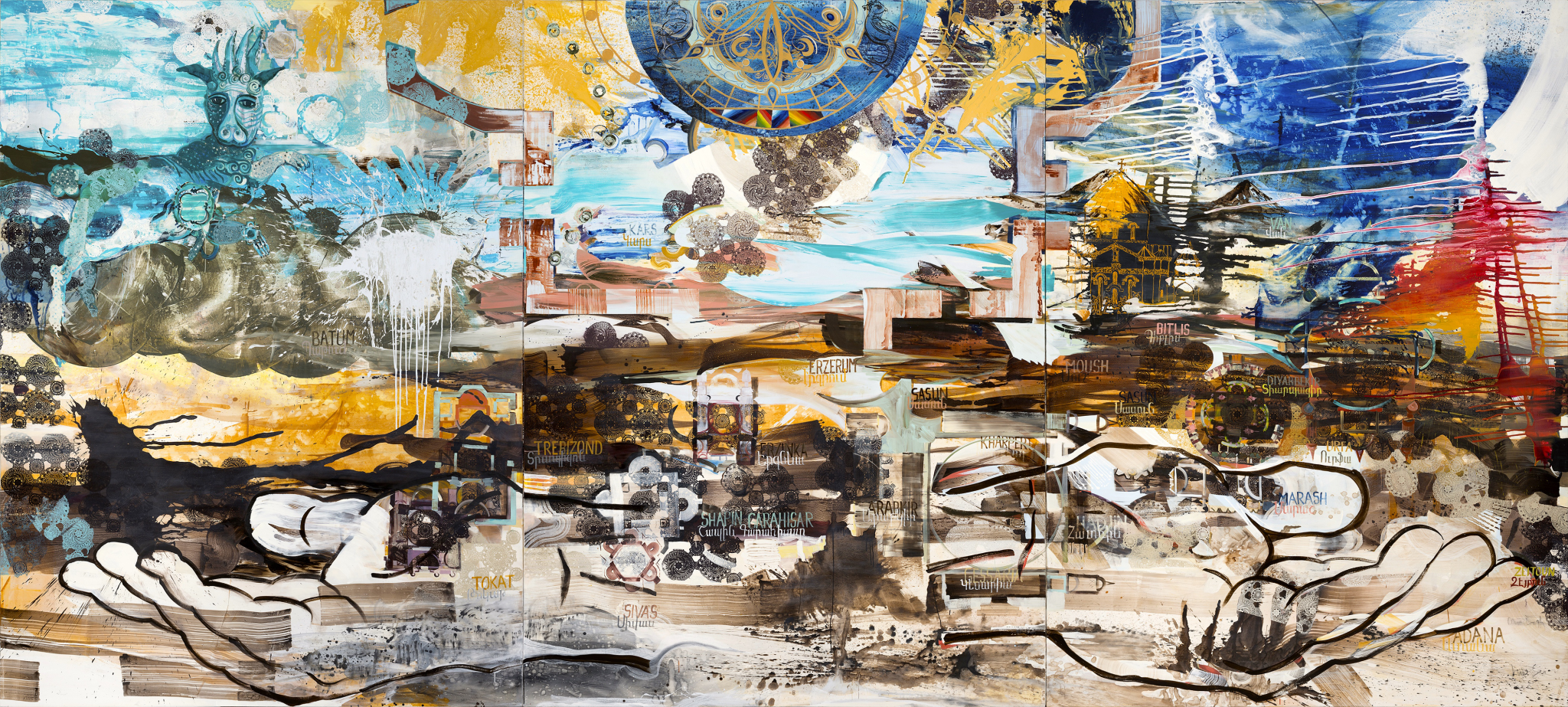Within the historical context of violent persecution, artists have continually attempted to manifest the tragedy and triumph of the human spirit, so that they may commemorate, celebrate, criticize, and perhaps even better understand themselves. Painter Jackie Kazarian navigates this ongoing narrative with her latest work, Armenia (Hayasdan), an impressive eleven-and-a-half by twenty-six foot painting which commemorates the one-hundredth anniversary of the Armenian Genocide.
Hanging in a gallery space at Mana Contemporary in Pilsen, the painting dutifully carries the historical and emotional weight of the first major genocide of the twentieth century—when 1.5 million Armenian subjects living in Ottoman Turkey were systematically killed, millions more forced to flee, and enormous parts of a rich culture almost entirely erased. This is the painting’s first stop of many on a tour across the United States as part of Project 1915, established by Kazarian to commemorate this anniversary.
Such far-reaching subject matter, however, does not come without a personal narrative; Kazarian, who is of Armenian descent and Chicago origin, is no exception. Her family was one of two Armenian families in her community—a result of her parents’ conscious decision to remove themselves from the Armenian community, choosing to speak English over their native language. This vast mural, however, is not the first time she has explored her heritage through painting. In the mid-1990s, when her last grandparent died, she created wallpaper-like works inspired by her childhood memories of the intricate wallpaper in her grandmother’s home. It was not until after thirty years of painting, Kazarian says, that she felt that she had reached a comfortable enough place in her career—professionally and stylistically—to make this painting.
“If I kept it personal throughout the whole process, I felt like I had a right to paint about this and could gain some sort of legitimacy,” Kazarian explained. That process began in March of last year, when she went to the Armenian Library and Museum of America in Watertown, Massachusetts, researching references and images that she would return to time and time again while working on the painting.
Kazarian’s own narrative aside, the success of the piece largely depends on its overwhelming visual qualities. Armenia (Hayasdan) has a deeply organic nature, demonstrated in the physicality of the bold paint strokes and its depiction of a sweeping landscape and sky. The terrain, however, is not without structural elements—Kazarian has painted an architecturally accurate church nestled in the middle ground of the piece, representing the rich religious background of Ottoman Turkey. The painting is monochromatic within the foreground but becomes increasingly colorful as the viewer’s eye travels towards what Kazarian calls the “celestial heavens.” At the forefront of the piece, though, is an uplifting sentiment, rather than one of grief or mourning.
“I wanted to celebrate the culture that survived in Armenia. But even with that, I knew in my gut that the sadness would come out,” Kazarian says.
Two personal aspects reaffirm the vibrancy of the piece in particular: silk-screened imprints of her grandmother’s handmade lace are scattered throughout, accompanied by two vast outlines of outstretched hands representing those of her grandmother. The hands do not give the impression of helplessness or plea but rather of comfort and security. “The thing that makes me tick is seeing beautiful things develop from difficult situations,” Kazarian says in a short documentary posted on her website.
While Kazarian finds herself in a position to express her personal connection to the event, she is also aware of her role in contextualizing the bigger picture. The goals of the painting are surely not singular. She attempts to commemorate while creating a sense of exposure for something that many people know nothing about.
“I want to bring attention to the general public, and create some sort of discourse on the travesty of genocide and what that means for our collective history,” Kazarian says. As for why some do not know much about the Armenian Genocide, Kazarian points toward the intentional erasure and mitigation of history by the modern-day Turkish and Armenian governments.
Early on, when Kazarian first thought up the idea to do a painting of such large scale, her mind turned to Picasso’s Guernica, a work commemorating the aerial bombing of the civilian population in the Spanish town of Guernica in 1937. Armenia (Hayasdan) is the same size as Guernica as a way to pay tribute to a work that responded to a tragedy so effectively.
Kazarian says “It had certain import when Picasso made Guernica, because he was so outraged. But people know about Guernica and remember it and know about the events because of that painting.” While Picasso and Kazarian’s responses to different tragedies are rightfully distinct from one another, both aim to raise awareness of particular occurrences.
As much as this painting may offer commemoration of an important anniversary, it comes with the hardening reminder that no matter how much time separates us from these travesties, they do not become less confounding. As Project 1915 continues, it is humbling to realize that the process of understanding such an event—and the personal narratives and widespread acknowledgment that should accompany it—is never finished.

